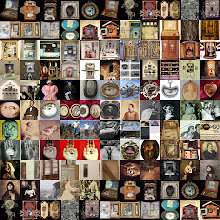
Lady Gaga's Judas single and videoclip from her latest album Born This Way references biblical images and characters, showing her as a new Mary Magdalene part of the apostles-gang who is torn between Jesus, her virture, and Judas, the evil she clings to. The video mixes the historical and contemporary in its aesthetics. The opening scene shows Gaga riding at the back of Jesus' motorbike, driving in the motorway with the rest of the gang, their black leather jackets with metal studs naming the apostles. They arrive at Jerusalem, like taken from a historical movie setting, with a neon sign that reads 'Electric chapel'.
The fake-artificial alludes to the religious ideal of purity in this im/perfect blend. Historic and religious notions of authentic are killed with a cheap plastic mask. The heavy, elaborate, excessive-extreme use of makeup; Jesus' glittery hair accesory/crown of spikes; the super-shiny false jewellery that imitates gold, the fake nails, the artificial wigs, and more neverending accesories from sunglasses to tacky glitering crucifixes.
Gaga has multiplying make-up faces: with every scene she changes costume, make-up, followed by her heavy accessory load, extras, setting, style, dance...

Lady Gaga in one of her characters, the Mary Magdalene fused with the Virgin Mary, sacred heart included, and performed as a rap gang member.

Gaga-authority/justice mediator figure
Side by side, Jesus and Gaga, as head of a gang, walk around a crowd blessing and saluting, while Judas instigates chaos and fights. There is a confrontation between Jesus and Judas mediated by Mary Magdalene-Gaga, where she is torn between having to choose a side, she can't but like a prophetess she marks Judas with red lipstick as the sinner, from those lips the kiss of betrayal shall come.

She washes the feet of both men, shows repentance and is kissed on the forehead by Jesus but the angry crowd stone her to death.
As Kevin Gaffney (MA Photography, Royal College of Art 2010) discusses in his paper The Lady Gaga Saga, she absorbs and reappropiates cultural references that become part of her myth, the result is a 'labyrinth of signs'. This reduction of culture to signs for sensory entertainment resonates with Braudillard's disscussion of the images of God, according to Gaffney. These images "concealed nothing at all, and that in fact they were not images,
such as the original model would have made them, but actually perfect simulacra forever
radiant with their own fascination.” (Baudrillard, 1983)
The queen of simulacrum and performance, Gaga "never takes off her mask" (Gaffney). She enacts 'being as performance':
"Stephanie Germanotta was born into the world, achieved her character from New
York club life and internalizing her favourite artists, and became her person; titling it
“Lady Gaga.” She is aware that the process of self-realisation & visualization must then
be performed publicly in order to become concrete in the minds of others. She calls this
“The Fame”(...) What better way to create your own myth than to write an album about your
predicted fame, so that when it happens, your listeners and fans know you are the
visionary you claim to be?" (p. 44, Gaffney)
Blurs artifice and performance with life, ever morphing her mask, she is orchestrator and not victim of her fame. She constructs her own identity, the fake becomes real, she enacts the being-as-performance, creating "all-performance-all-the-time reality." (Phelan, Peggy).
She is the postmodern trickster, the mythic star of a new cult.



